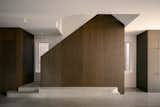How They Pulled It Off: A Historical Toronto Home With a Wellness Zone in the Basement
Welcome to How They Pulled It Off, where we take a close look at one particularly challenging aspect of a home design and get the nitty-gritty details about how it became a reality.
How do you get a 60 percent increase in living space without altering a home’s original envelope? For Studio VAARO, the answer was a feat of what cofounder Francesco Valente-Gorjup called "structural gymnastics."
The Toronto-based firm was tapped to renovate a semidetached Edwardian home in the city’s charming, close-knit Republic of Rathnelly, a neighborhood that attempted to secede from Canada in the 1960s. "It’s a community with a strong sense of pride and camaraderie," says cofounder Aleris Rodgers. "As such, it’s critical to be respectful with how you approach renovations to turn-of-the-century homes like this one." The challenge: modernize and reorganize without much disruption to its street-facing facade.
Instead of building out, they dug down, excavating more than four feet—a move the subcontractor said "was one of the craziest digs they’d ever done," Rodgers says. The team also redistributed the floor plates and lowered the ground floor to just one step above grade, dramatically altering the layout.
Inside, a sculptural stair stitches the three levels together with two primary zones per floor: the kitchen and living on the main level, the primary suite and library upstairs, and a guest/yoga room and child’s bedroom tucked above.
But it’s the basement that may be the most unexpected success. Wrapped in deep blue tile and polished concrete, it functions as both a wellness zone and high-performance sports hub.
How they pulled it off: A thoughtful revamp from the basement up
- A spa with an industrial edge: "[Our clients] lead a very active lifestyle—they’re into mountain biking, surfing, snowboarding, and golf," says Valente-Gorjup. The sleek shower doubles as a bike-washing station, complete with a concealed high-pressure hose, sand trap, and commercial-grade drain. "We didn’t want the basement to just feel like a sports equipment storage room; it also had to function as a tranquil refuge," he adds.
An evolving feature staircase: The puzzle-like stair achieves cohesion "using geometry and materiality," Rodgers says. It begins with a concrete bench before transitioning with warm walnut-stained wood like "a monolithic chunk of carved wood," and then again with curving drywall, she notes.
Monolithic moments: Inspired by the client’s career in fashion, the custom closet reads like a freestanding boutique display with open and closed storage. In the powder room, a triangular recessed sink avoids protrusion while referencing the geometry of the primary bath. "It’s fun when you know what’s on the other side," she says.
A Euro-leaning kitchen with built-in dining: The pill-shaped island posed a material challenge. "We couldn’t build it out of just any material," Rodgers says, as they wanted to maintain the curvilinear language. "Wood countertops are relatively rare in North America but more common in northern Europe. The island is one-inch solid oak so it can be sanded over time; it also matches the cabinetry."
Project Credits:
Architect of Record: Aleris Rodgers and Francesco Valente-Gorjup, Studio VAARO / @studiovaaro
Builder/General Contractor: Whitaker Construction
Structural Engineer: Matthew Kieffer / Kieffer Structural Engineering
Mechanical Engineer: Giovanna Rea / RDZ Engineers LTD
Lighting Design: Aleris Rodgers and Francesco Valente-Gorjup, Studio VAARO / @studiovaaro
Photographer: Félix Michaud
Related Reading:
How They Pulled It Off: Multigenerational, Accessible Living in a Century-Old Home
How They Pulled It Off: Warming Up a Concrete Basement to Match a Plywood Home
Updated 8/5/25: Due to an editing error, this piece previously misstated the layout of the home’s basement. It has also been updated to more accurately reflect changes that had been made to the facade.
Published
Topics
How They Pulled It OffGet the Dwell Newsletter
Be the first to see our latest home tours, design news, and more.






